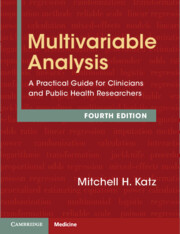
-
Select format
-
- Publisher:
- Cambridge University Press
- Publication date:
- October 2025
- October 2025
- ISBN:
- 9781009558488
- 9781009558471
- Dimensions:
- Weight & Pages:
- Dimensions:
- (246 x 189 mm)
- Weight & Pages:
- 0.55kg, 282 Pages
You may already have access via personal or institutional login
Book description
Now in its fourth edition, this best-selling, highly praised text has been fully revised and updated with expanded sections on propensity analysis, sensitivity analysis, and emulation trials. As before, it focuses on easy-to follow explanations of complicated multivariable techniques including logistic regression, proportional hazards analysis, and Poisson regression. The perfect introduction for medical researchers, epidemiologists, public health practitioners, and health service researchers, this book describes how to preform and interpret multivariable analysis, using plain language rather than mathematical formulae. It takes advantage of the availability of user-friendly software that allow novices to conduct complex analysis without programming experience; ensuring that these analyses are set up and interpreted correctly. Numerous tables, graphs, and tips help to demystify the process of performing multivariable analysis. The text is illustrated with many up-to-date examples from the published literature that enable readers to model their analyses after well conducted research, increasing chances of top-tier publication.
Contents
Metrics
Altmetric attention score
Full text views
Full text views help Loading metrics...
Loading metrics...
* Views captured on Cambridge Core between #date#. This data will be updated every 24 hours.
Usage data cannot currently be displayed.
Accessibility standard: Missing or limited accessibility features
Why this information is here
This section outlines the accessibility features of this content - including support for screen readers, full keyboard navigation and high-contrast display options. This may not be relevant for you.
Accessibility Information
The PDF of this book is known to have missing or limited accessibility features. We may be reviewing its accessibility for future improvement, but final compliance is not yet assured and may be subject to legal exceptions. If you have any questions, please contact accessibility@cambridge.org.
Content Navigation
Table of contents navigation
Allows you to navigate directly to chapters, sections, or non‐text items through a linked table of contents, reducing the need for extensive scrolling.
Index navigation
Provides an interactive index, letting you go straight to where a term or subject appears in the text without manual searching.
Reading Order and Textual Equivalents
Single logical reading order
You will encounter all content (including footnotes, captions, etc.) in a clear, sequential flow, making it easier to follow with assistive tools like screen readers.
Full alternative textual descriptions
You get more than just short alt text: you have comprehensive text equivalents, transcripts, captions, or audio descriptions for substantial non‐text content, which is especially helpful for complex visuals or multimedia.
Visualised data also available as non‐graphical data
You can access graphs or charts in a text or tabular format, so you are not excluded if you cannot process visual displays.
Visual Accessibility
Use of colour is not sole means of conveying information
You will still understand key ideas or prompts without relying solely on colour, which is especially helpful if you have colour vision deficiencies.
Use of high contrast between text and background colour
You benefit from high‐contrast text, which improves legibility if you have low vision or if you are reading in less‐than‐ideal lighting conditions.

